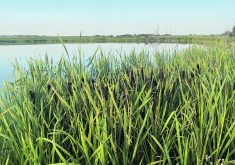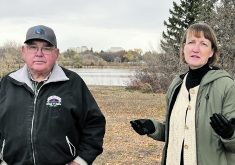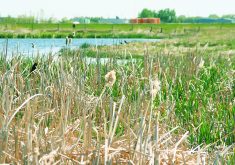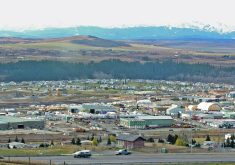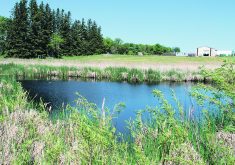Project aims to determine how long wetlands can sustain current treatment levels and how the process can be improve
Researchers at the University of Lethbridge are looking at how treated water being discharged into a wetland from a town and a meat processing facility is being dispersed into the wider watershed.
Part of the five-year study will focus on the Frank Lake wetland located near High River, Alta., home to Cargill’s meat processing facility, one of the largest in the country. The aim is to understand how long the wetlands can sustain current treatment levels and how the process can be improved.
Matt Bogard, assistant professor of biology at U of L, said the Frank Lake wetland is part of a reclamation effort by Ducks Unlimited, which manages the site. He said effluent from the town and meat packing facility help maintain water levels.
Read Also

VIDEO: Agritechnica Day 4: Robots and more robots, Nexat loves Canada and the trouble with tariffs
Agritechnica Day 4: Robots and more robots, Nexat loves Canada and the trouble with tariffs.
Such watersheds allow for a buffer to droughts, provides habitat for birds, provides an additional filter for effluent, protects biodiversity and stores carbon, said Bogard.
“The thing about Frank Lake is that it’s been treating effluent for a number of decades and the stakeholders in the watershed of the Little Bow River and inhabitants that use the Twin Valley Reservoir downstream want to understand how best to manage this watershed,” he said.
The $1.5 million study is partially funded by Cargill, with matching funds provided by the Natural Sciences and Engineering Research Council. Cargill, the Town of High River and Ducks Unlimited have had an agreement in place since the 1980s to release effluent to Frank Lake.
Bogard said this agreement has allowed effluent diversion “to sustain water levels in the wetland to support waterfowl and other organisms, while also using the wetland as an additional treatment step.”
The wider implication of the study is to understand the impacts to downstream users, said Bogard.
“Every community deals with waste water and effluent and depending on their available funding, the level of water treatment and the approaches people take to treating their waste water varies,” he said. “(Frank Lake) is a good model as it is going to allow us to understand the potential for wetlands to help remediate treated effluent.”
The research will be particularly focused on how much the wetland filters nutrients, salts and other chemicals from treated effluent as it moves from Frank Lake down to the Twin Valley Reservoir.
“We’re not just stopping at the source, we’re tracking the water as it moves downstream,” said Bogard.
That tracking method includes taking water samples along the course of the downstream flow, which are then analysed by U of L staff.
The study is in its first of five years and it’s too early to release findings.
“But I can say that different components in waste water and in overland runoff from different activities in the watershed will do different things,” he said.
Those components include effluent, and also inputs from agriculture and livestock as well as the alterations the water might go through depending on the speed of the stream flows.
In time, the study will be able to identify what materials are being effectively filtered and which aren’t, Bogard added.
The length of time of the study will allow researchers to provide “a more comprehensive picture to the stakeholders what the conditions are in these systems and how they might change from one year to the next.”
Frank Lake is located six kilometres east of High River. Birds Calgary lists it as one of the best locations to view birds.





